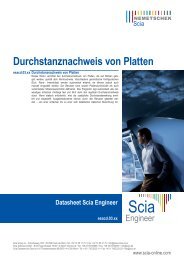Advanced Package Training Scaffolding 2011.1 - Scia-Software GbR
Advanced Package Training Scaffolding 2011.1 - Scia-Software GbR
Advanced Package Training Scaffolding 2011.1 - Scia-Software GbR
Create successful ePaper yourself
Turn your PDF publications into a flip-book with our unique Google optimized e-Paper software.
18. User Blocks<br />
82<br />
<strong>Advanced</strong> <strong>Training</strong><br />
The application of user blocks can be divided into three independent steps. The steps must be carried out in<br />
the given order and all of them must be made.<br />
1. Creating the user block<br />
A user block can be created as a standard project. There are no explicit restrictions to it. Usually,<br />
the user will be working on his/her project and either at the end or some time during the design<br />
phase s/he decides to make a user block of the current state of the project.<br />
Then the only thing that must be done is save the project to the disk. It may be useful, however not<br />
compulsory, to use function Save As and give the project such a name that gives a hint about the<br />
structure in the project.<br />
2. Storing the user block to the library<br />
In order to be usable as a user block, the project must be stored in the User block library folder<br />
(see Program settings > Directory settings). This may be achieved in two ways.<br />
• The user specifies the proper path in the Save As dialogue (see paragraph above) and<br />
saves the project directly to the User block library folder.<br />
• The user saves the project to his/her common project folder and then copies the file to the<br />
User block library folder. The file may be copied in any file-management tool (e.g.<br />
Windows Explorer, Total Commander, My Computer dialogue, etc.)<br />
Tip: The user blocks may be stored not only in the given User block library folder, but they may be<br />
arranged in a tree of subfolders. The subfolders may then group user blocks that have something in<br />
common. This arrangement may lead to easier and clearer application of user blocks, especially if a<br />
long time passes from the time they were created and stored.<br />
When using this tip, all the subfolders can be chosen:















